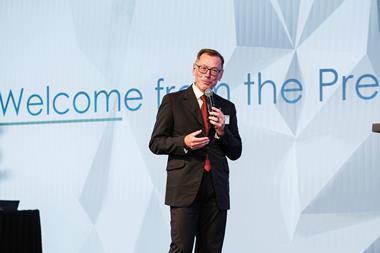 The outlook for the European finished vehicle sector remains positive, with growth still forecast for the short to medium term, according to figures presented at the Spring Congress of the Association of European Vehicle Logistics (ECG) in Malta last week. But a slower growth rate is beginning to lead to a build-up in stocks, warned the association.
The outlook for the European finished vehicle sector remains positive, with growth still forecast for the short to medium term, according to figures presented at the Spring Congress of the Association of European Vehicle Logistics (ECG) in Malta last week. But a slower growth rate is beginning to lead to a build-up in stocks, warned the association.
Figures presented at the event by Justin Cox, director of global production at analyst LMC Automotive, showed that while there was significant regional variation in sales targets across the European regions, growth in sales was expected to continue this year, albeit at a lower rate than last year.
LMC Automotive suggested the 6.2% growth seen in Europe (excluding Russia) in 2016 – which resulted in a total of 18.5m light vehicle sales – would slide back this year to 2.2%, leading to total sales of around 18.9m. In the medium term to 2022, meanwhile, LMC Automotive foresees sales growth of around 2.3% in Europe (excluding Russia and the UK).
In terms of production, LMC figures suggest growth in the light vehicle sector will more than halve this year in Europe (excluding Russia), falling from 3.3% in 2016, when 20.3m vehicles were made, to just 1.4%, to leave vehicle production at 20.5m units.
“The expectation is that producers will slow down because they want to manage demand and supply; they don’t want to be overstocked and have to make big cuts further on or incentivise,” said Cox.
Inventory at the top eight vehicle producers in Europe increased by eight days in the first quarter of this year, compared to the same period in 2016 – and those inventory levels are at variance with last year’s figures, Cox suggested. There is also too much variance between the premium and non-premium sectors, he noted, with the former becoming too lean and the latter becoming a little ‘overweight’.
Exports have not been helping production in Europe during the first half of 2017 either, with markets such as China remaining flat on imports as strong domestic production of a broader range of models by localised carmakers meets demand.
Higher occupancy, slower movementFor transport and logistics operators, this slowdown is leading to a build-up of inventory at storage facilities and a slowdown in the movement of stock to dealerships.
Wolfgang Göbel, chief sales officer at German finished vehicle transport provider Mosolf Group and president of the ECG, acknowledged that vehicle occupancy at compounds and ports was higher than last year and that vehicles were not moving at the same rate as in 2016.
“What I can say for our market in Germany is that the stock is not moving that fast anymore,” he said. “There is also a high number of lease cars coming back faster to our compounds after a short period of usage.”
The problem is exacerbated by inaccuracy in some of the forecasts provided by carmakers, Göbel suggested. Mosolf had seen a significant drop in transport in the first quarter compared to the same period last year, but the forecast data it had received from carmakers had suggested there would be little change, he said.
Given the reliance of transport providers and terminal operators on such data in managing their assets, such inaccuracies could lead to serious inefficiencies in the use of assets and the provision of services, he warned.
“The forecast is produced by the OEMs and most of the time it is not based on production but more on the sales expectations they have for the coming week, month or year,” explained Göbel. “What we see are significant deviations.”
Feeding into forecastingMore accurate and timely information from OEMs could obviously improve the situation, which is part of the thinking behind a working group the ECG established recently with close links to the carmakers.
“We will, with the OEMs, develop a standard tool for any kind of forecasting and any kind of supply chain in finished vehicle logistics,” promised Göbel. The tool will require a ‘translation’ of all the different forecasts providers receive for any given period into one system, he said.
The move to develop a forecasting standard addresses an issue identified in an efficiency survey the ECG conducted four years ago. According to Mike Sturgeon, executive director of the association, members were surveyed on the main causes of inefficiency in the outbound supply chain. “The top one for everyone was inaccurate forecasts,” said Sturgeon.
[related_topics align="right" border="yes"]“There are huge variations in the industry about how the various OEMs come up with their forecasts,” he continued. “Some are quite professionally done and sensible – and others are just dreaming with very little science behind them.”
Both Göbel and Sturgeon suggested the current slowdown in the European market was encouraging carmakers to listen to their logistics service providers.
“In the current market situation, the OEMs are listening to us more than before and they see that they also have to do their part of the job, because we can only improve with them,” Göbel noted.
“Generally I would say that cross-industry relations between the OEMs and the LSPs are better than they have ever been in terms of the cooperation and the desire to work together to improve things,” added Sturgeon.





































